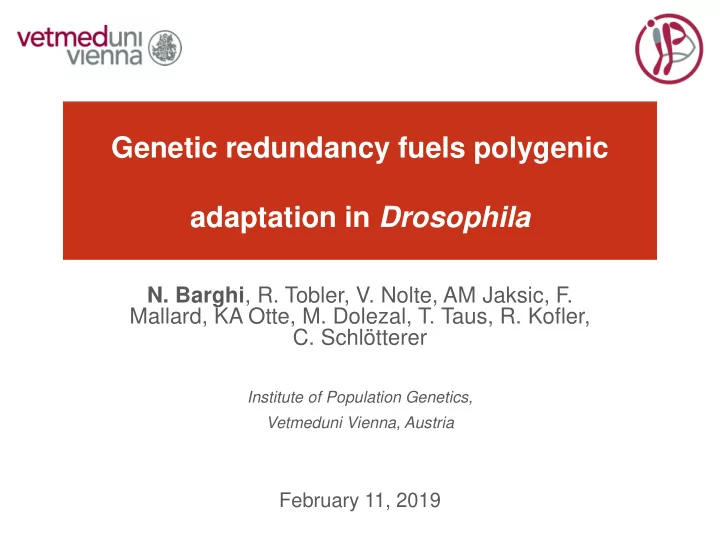

Genetic redundancy fuels polygenic adaptation in Drosophila N. Barghi , R. Tobler, V. Nolte, AM Jaksic, F. Mallard, KA Otte, M. Dolezal, T. Taus, R. Kofler, C. Schlötterer Institute of Population Genetics, Vetmeduni Vienna, Austria February 11, 2019
Adaptive traits • Most molecularly characterized traits have simple genetic basis • pigmentation (Hoekstra 2006; Hof et al. 2016, Jones et al. 2018) • lactose persistence (Tishkoff et al. 2007) • resistance to • viruses (Magwire et al. 2012) • insecticides (Daborn et al. 2002) • malaria (Hamblin and Di Rienzo 2000) https://catherinephamevolution.weebly.com/ the-british-peppered-moth.html https://www.lalpathlabs.com/blog/what-is-malaria-fever/
Adaptive traits • Most molecularly characterized traits have simple genetic basis • pigmentation (Hoekstra 2006; Hof et al. 2016, Jones et al. 2018) • lactose persistence (Tishkoff et al. 2007) • resistance to • viruses (Magwire et al. 2012) • insecticides (Daborn et al. 2002) • malaria (Hamblin and Di Rienzo 2000) https://catherinephamevolution.weebly.com/ the-british-peppered-moth.html https://www.lalpathlabs.com/blog/what-is-malaria-fever/ • Selective sweep Burke 2012
Adaptive traits • Most adaptive traits are polygenic • Prediction: small allele frequency changes across many contributing loci
Adaptive traits • Most adaptive traits are polygenic • Prediction: small allele frequency changes across many contributing loci • Artificial selection experiments and QTL studies in Drosophila (Yoo 1980; Weber 1996; Gilligan and Frankham 2003) • Human height (Yang et al. 2010; Wood et al. 2014) • blood lipid levels (Willer and Mohlke 2013) • basal metabolic rate (Eijgelsheim et al. 2017) https://www.yourgenome.org/stories/fruit-flies-in-the-laboratory https://medicalxpress.com/news/2017-02-genes-height-revealed-global-people.html
Experimental evolution Franssen et al. 2015
Polygenic adaptation of a quantitative trait after a shift in trait optimum Franssen et al. 2017
Laboratory natural selection to a new temperature regime Pool-Seq https://gcocs.org/map-of-florida-gulf-coast-beaches/ Tallahassee, Florida, USA N = 1000
Evolved replicates have higher fitness, higher metabolic rate and lower fat content
Phenotypic convergence among evolved replicates
First glance; many putative targets of selection Significant allele frequency change between the founder and F60 populations (Cochran-Mantel-Haenszel: CMH test)
Reconstruction of haplotype blocks from Pool-Seq • In haplotypes starting from low frequencies, allele frequency trajectories of selected and hitchhiking SNPs are correlated across time and replicates ( Franssen et al. 2016 )
Multiple adjacent haplotype blocks * • 52,199 candidate SNPs (5% FDR – corrected q- values of CMH and Fisher’s exact tests) • Minimum allele frequency change 0.2 in at least 2 replicate, Window size 1Mb, correlation coefficient 0.75
Multiple adjacent haplotype blocks *
Multiple adjacent haplotype blocks *
Reconstruction of a large haplotype block from multiple haplotype blocks
Validation of reconstructed haplotype blocks
Characteristics of 99 selected alleles
Genomic heterogeneity among evolved replicates
Genomic heterogeneity among evolved replicates
Genomic heterogeneity among evolved replicates
Genomic heterogeneity among evolved replicates
Genomic heterogeneity doesn’t fit the sweep paradigm Constant s across replicates and no linkage
Genomic heterogeneity doesn’t fit the sweep paradigm With linkage and a constant s across replicates
Low genomic similarity among evolved replicates
Genomic heterogeneity fits genetic redundancy paradigm
Quantitative trait after a shift in trait optimum 4 3 Fitness 2 1 −4 −3 −2 −1 0 1 Phenotype
Quantitative trait after a shift in trait optimum 4 3 Fitness 2 1 −4 −3 −2 −1 0 1 Phenotype
Quantitative trait after a shift in trait optimum 4 3 Fitness 2 1 −4 −3 −2 −1 0 1 Phenotype
Genomic heterogeneity fits a quantitative trait paradigm QT paradigm without linkage 4 3 Fitness 2 1 −4 −3 −2 −1 0 1 Phenotype
Genomic heterogeneity fits a quantitative trait paradigm QT paradigm with linkage 4 3 Fitness 2 1 −4 −3 −2 −1 0 1 Phenotype
QT and redundancy paradigms fit the RFS of the empirical data better than selective sweep paradigm
Replicates in selective sweep paradigm are more similar than the empirical data and QT paradigm
Summary • Natural D. simulans populations harbour a vast reservoir of adaptive variation facilitating rapid evolutionary responses. • Genomic heterogeneity fits polygenic adaptation with quantitative trait paradigm. • Genetic redundancy provides multiple genetic pathways leading to phenotypic convergence. • No evidence of strong genetic constraint
Following the predictions of QT paradigm, the median frequency of selected alleles plateau Franssen et al. 2017
Following the predictions of QT paradigm, the median frequency of selected alleles plateau 4 3 Fitness 2 1 −4 −3 −2 −1 0 1 Phenotype Franssen et al. 2017
Following the predictions of QT paradigm, the median frequency of selected alleles plateau 4 3 Fitness 2 1 −4 −3 −2 −1 0 1 Phenotype Franssen et al. 2017
Prominent allele frequency shift in early generations of adaptation
Plateau and drift in allele frequencies in later generations of adaptation
Genomic heterogeneity persists even after 130 generations of adaptation
Genomic heterogeneity persists even after 130 generations of adaptation
Recommend
More recommend